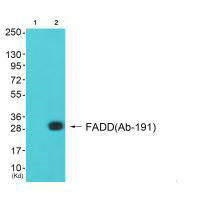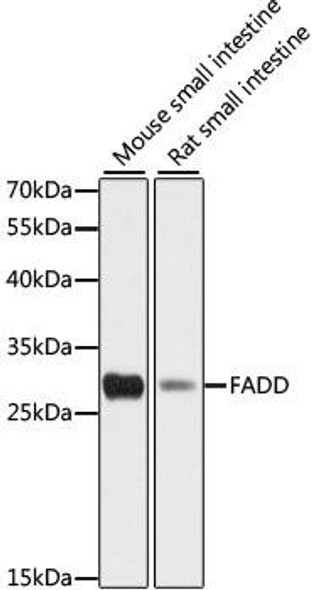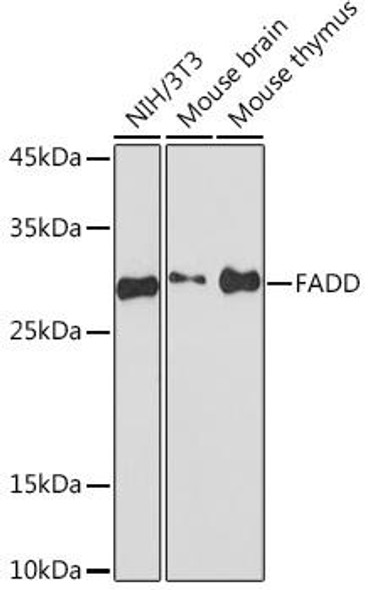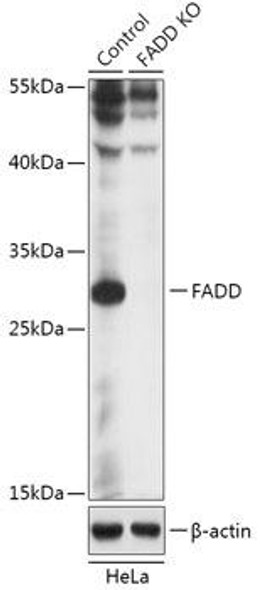Description
FADD (Ab-191) Antibody (PACO21634)
The FADD AB-191 Polyclonal Antibody is a powerful tool for research involving Fas-associated death domain (FADD), a key protein involved in apoptosis. This antibody, produced in rabbits, is highly specific for human samples and has been validated for use in a variety of applications including Western blotting and immunohistochemistry. By targeting the FADD protein, this antibody allows for precise detection and analysis of cellular pathways related to apoptosis, making it an essential component in studies focused on cell death mechanisms and the development of antitumor therapies.
FADD is a crucial adaptor molecule in the extrinsic apoptosis pathway, mediating the activation of caspase-8 and ultimately leading to cell death. Dysregulation of FADD expression has been linked to various diseases, including cancer and autoimmune disorders, making it a promising target for therapeutic interventions. By elucidating the role of FADD in these pathological processes, researchers can gain valuable insights into potential treatment strategies aimed at restoring normal cell function and preventing disease progression.
| Antibody Name: | FADD (Ab-191) Antibody (PACO21634) |
| Antibody SKU: | PACO21634 |
| Size: | 100ul |
| Host Species: | Rabbit |
| Tested Applications: | ELISA, WB |
| Recommended Dilutions: | ELISA:1:2000-1:10000, WB:1:500-1:3000 |
| Species Reactivity: | Human, Mouse |
| Immunogen: | Synthesized peptide derived from C-terminal of human FADD. |
| Form: | Liquid |
| Storage Buffer: | Rabbit IgG in phosphate buffered saline (without Mg2+ and Ca2+), pH 7.4, 150mM NaCl, 0.02% sodium azide and 50% glycerol. |
| Purification Method: | The antibody was affinity-purified from rabbit antiserum by affinity-chromatography using epitope-specific immunogen. |
| Clonality: | Polyclonal |
| Isotype: | IgG |
| Conjugate: | Non-conjugated |
 | Western blot analysis of extracts from A549 cells (Lane 2), using FADD (Ab-191) antiobdy. The lane on the left is treated with synthesized peptide. |
| Background: | Apoptotic adaptor molecule that recruits caspase-8 or caspase-10 to the activated Fas (CD95) or TNFR-1 receptors. The resulting aggregate called the death-inducing signaling complex (DISC) performs caspase-8 proteolytic activation. Active caspase-8 initiates the subsequent cascade of caspases mediating apoptosis By similarity. Involved in interferon-mediated antiviral immune response, playing a role in the positive regulation of interferon signaling By similarity. Hsu H., Cell 84:299-308(1996). |
| Synonyms: | FADD; Fas (TNFRSF6)-associated via death domain; FAS-associated death domain protein; FAS-associating death domain-containing protein; Fas-associating protein with death domain |
| UniProt Protein Function: | FADD: an adaptor molecule that mediates apoptosis. Recruited through its C-terminal death domain by Fas-receptor, tumor necrosis factor receptor, TNFRSF25, and TRAIL-receptor, participating in the death signaling initiated by these receptors. Interaction with the receptors unmasks the N-terminal effector domain of this protein, which recruits caspase-8, and thereby activates the cysteine protease cascade. Knockout studies in mice also suggest the importance of this protein in early T cell development. |
| UniProt Protein Details: | Protein type:Adaptor/scaffold; Apoptosis Cellular Component: CD95 death-inducing signaling complex; cytoplasm; cytosol; lipid raft; neuron projection; plasma membrane; protein complex Molecular Function:death receptor binding; identical protein binding; protease binding; protein binding; protein complex binding; tumor necrosis factor receptor binding; tumor necrosis factor receptor superfamily binding Biological Process: apoptosis; cardiac muscle development; defense response to virus; innate immune response; lymph node development; positive regulation of activated T cell proliferation; positive regulation of adaptive immune response; positive regulation of apoptosis; positive regulation of interferon-gamma production; positive regulation of interleukin-8 production; positive regulation of macrophage differentiation; positive regulation of proteolysis; positive regulation of T cell mediated cytotoxicity; positive regulation of transcription from RNA polymerase II promoter; positive regulation of tumor necrosis factor production; protein heterooligomerization; spleen development; T cell differentiation; T cell differentiation in the thymus; T cell homeostasis; thymus development |
| UniProt Code: | Q61160 |
| NCBI GenInfo Identifier: | 2498356 |
| NCBI Gene ID: | 14082 |
| NCBI Accession: | Q61160.1 |
| UniProt Secondary Accession: | Q61160,Q3TC37, Q61082, |
| UniProt Related Accession: | Q61160 |
| Molecular Weight: | 22,960 Da |
| NCBI Full Name: | FAS-associated death domain protein |
| NCBI Synonym Full Names: | Fas (TNFRSF6)-associated via death domain |
| NCBI Official Symbol: | Fadd |
| NCBI Official Synonym Symbols: | Mort1/FADD |
| NCBI Protein Information: | FAS-associated death domain protein |
| UniProt Protein Name: | FAS-associated death domain protein |
| UniProt Synonym Protein Names: | FAS-associating death domain-containing protein; Mediator of receptor induced toxicity; Protein FADD |
| Protein Family: | Fas-associated death domain protein |
| UniProt Gene Name: | Fadd |
| UniProt Entry Name: | FADD_MOUSE |











